- WELCOME
- HOME
- ABOUT US
- CHAMPIONS
-
VERY IMPORTANT DOG
- Ch. South Fork's Jelly Bean
- Ch. South Fork's The Beat Goes On
- Ch. Yo Te Quiero Di Rio Galeria
- Ch. South Fork' Jazz It Up
- Ch. Tocai Di Rio Galeria
- Ch. South Fork's Contradiction
- Ch. South Fork's Music Man
- Ch. El Nino Di Rio Galeria
- Ch. Xsaraja Di Rio Galeria
- Ch. De Gozette Lotus
- Ch. Eldorado Di Rio Galeria
- Ch. Jaqueline Di Rio Galeria
- Ch. Dacarella's Hellf Angel
- SHOW RESULTS
- PUPPIES
- INFO CHIHUAHUA
- CONTACTS
- TOOLS
Dog Expertise
By Paolo Tartaro and Francesco di Paola Nuzzo
- Source: Magazine All About Chihuahua n° 5
| In the fifth article of the AAC magazine, we will deepen the description of the trunk, given the importance and complexity of this morphological region. And we will continue to talk about it in the next issue. The skeletal structure of the trunk is formed by: spine, chest, rib and pelvic girdle. In the previous issue, we have already described the shoulder region of the trunk and cornerstone of the movement. The examination of the dog's trunk in zootechnics basis is of great functional and type significance. In the trunk you will easily find the breed's features, but only a trained eye will be able to quickly identify the ethnic characters. Undoubtedly, the head is the region that more than others expresses the characters of type. To facilitate the examination of the trunk you need to use some evaluation criterion such as: proportions, profile and angulations. The comparison between height and length of the body allows us to observe just two geometric shapes in which it is inscribed: square and rectangle. In the latest chihuahua standard, drawn by the FCI on the 21st of October 2009, please note that the body should be, nearly, inscribed in the square, cylindrical, sturdy and solid with good muscle and bone development, without any fault. The almost square trunk (which is slightly longer than high), given by the ratio between length and height, is a type character of our little Mexican dog. The top line of the body is straight and level, the lower back slightly ascending in the ventral region, with a raised belly to avoid the obese effect. The great masters of Dogscience (Solaro, Barbieri and Bonetti) teach us: "... ... to be inscribed in one or other geometrical figure is not trivial, because it involves: appearance, outer conformation, breed gait and structure ...." In all breeds the characteristics of type must be sought and accurately examined, because it is what distinguishes one breed from another breed. A subject lacking the breed characters can not be described as excellent (the highest qualification obtainable in dog shows) in zootechnics basis, though apparently correct. |
|
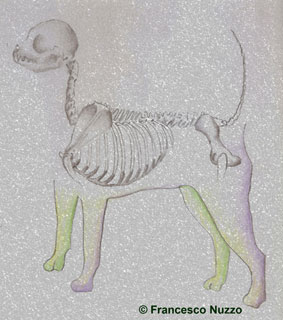 |
Spinal column or Rachis |
| Chest Breast Ribs and Sternum Chest Conical cavity whose anatomical basis is the rib cage (ribs, thoracic vertebrae and sternum). The chest contains: circulatory and respiratory organs. A proper chest development has three dimensions: • Length or depth (sagittal diameter) • Height (vertical diameter) • Width (transverse diameter) A proper development of the three diameters above mentioned has a threefold importance in the subject: vital, functional and of type. It also ensures proper ventilation. The chest in our little breed is wide, deep, with ribs well curved. The width of the chest is given by the camber of the ribs, with a front-rear trend , this measurement is made between the two points of maximum bilateral hoops. The chest height is measured vertically from the top of the back, immediately after the withers to the sternum. |
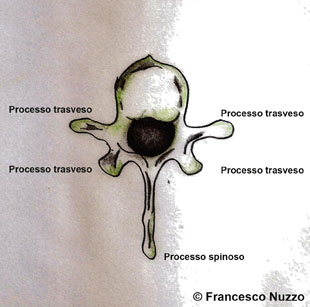 |
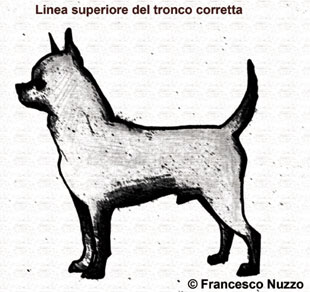 |
The chest in the Chihuahua, viewed laterally, reaches the elbow, should never be as a barrel. |
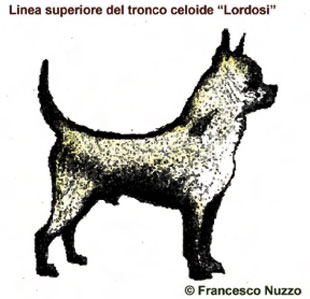 |
|
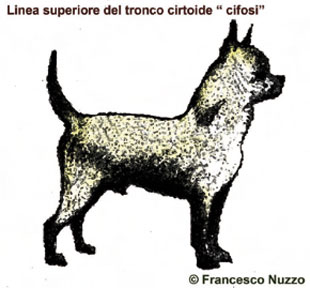 |
diriogaleria@chihuahua.it | musicvelvet@chihuahua.it
Words and images ©2011 Di Rio Galeria & Music Velvet Kennels - All rights reserved | Web site by TwentyfourCatsandDogs ©
